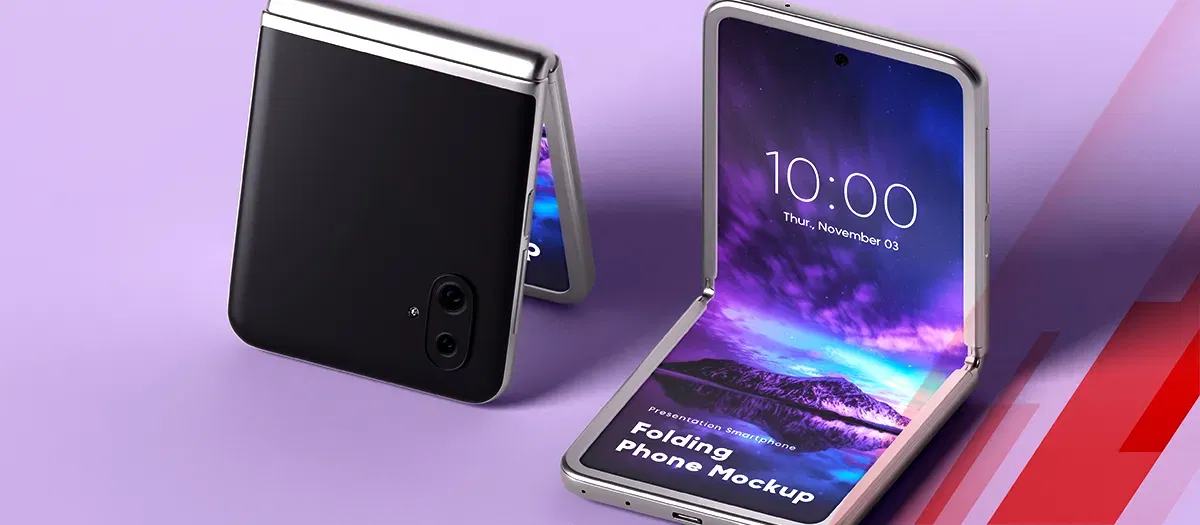Many of us have noticed the emergence of foldable smartphones and TVs. But, have you ever pondered the intricacies of these devices and how they achieve their flexibility? Well, the secret lies in the foldable display technology. In the following discussion, we explained the inner workings of these devices and the innovations contributing to their widespread appeal.
Let's dive in!
What are Foldable Displays?
Foldable displays, or foldable screens, are a type of screen technology that can be bent or folded without damaging the display. They offer a flexible and versatile form factor, allowing devices to have larger screens that can be folded into a more compact size for portability. Displays with foldable technology are typically made using flexible OLED (organic light-emitting diode) technology, which allows the display to be thin and bendable.
Foldable screens are also known as flexible displays. These displays have gained attention in recent years, particularly in the smartphone industry, for their ability to enable devices with larger screens while still maintaining portability. As per a recent report by Kings Research, the global foldable display market is likely to reach $28.33 billion by 2030, growing at a CAGR (compound annual growth rate) of 8% from 2023 to 2030.
Exploring the Pivotal Types of Foldable Displays
Below are the common types of foldable screens widely used in various applications.
- Flexible OLED displays
These displays utilize flexible OLED (organic light-emitting diode) technology. It can be bent, rolled, or folded without damaging the display. Offer thin and lightweight form factors. These displays provide enhanced flexibility and durability when compared to traditional rigid displays. It is widely used in various devices, including smartphones, tablets, and wearables.
- Multi-Fold Displays
These displays can be folded multiple times, both inward and outward. They offer a compact form factor when folded and a larger screen when unfolded. Multi-fold displays improve multitasking and productivity by providing more screen space. Examples of these devices include the Xiaomi foldable display smartphone.
- Clamshell Displays
Clamshell displays consist of two separate displays joined by a hinge. When unfolded, they provide a larger, continuous screen. Microsoft Surface Duo is the best example of these screens, which feature two displays that can be used independently or together.
- Foldable Tablet Displays
A larger, foldable screen is designed for tablet-like experiences. These displays offer the convenience of a larger screen while maintaining portability. They can be folded into a more compact size for easy carrying.
- Foldable Laptop Displays
These screens aim to provide a more versatile computing experience. They combine the functionality of a laptop and a tablet. Foldable laptop displays offer flexible screens that can be folded or adjusted to different angles. A prominent example is a prototype like Intel foldable-screen computer.
- Foldable Display Form Factors
Various designs and configurations of foldable screens include inward fold, outward fold, multi-fold, and clamshell form factors. Each form factor such as size and shape offers unique benefits and use cases. Manufacturers are actively engaged in ongoing innovation and the exploration of novel form factors for foldable displays.
Recent Innovations in the Foldable Display Technology
Below are the recent innovations in foldable screen technology that are boosting the popularity of foldable devices in the industry.
1. Multitasking Foldable Screen Smartphones
Foldable smartphones have become an integral part of our daily lives due to the innovative contribution of Samsung Electronics. In August 2023, Samsung introduced the Galaxy Z Fold5, the lightest and most groundbreaking foldable smartphone. It features a 7.6-inch main screen, the snapdragon 8 gen 2 mobile platform, an improved taskbar, two-handed drag and drop, and a hidden pop-up feature. The S Pen Fold Edition offers a slimmer design for creativity and offers multiple screens and multitasking. The Galaxy Z Fold5 is made from recycled materials, including pre-consumer glass, aluminum, and post-consumer plastics. The packaging is made from 100% recycled material, reflecting Samsung's sustainability mission.
2. Adaptive Display Technology
Motorola has introduced an adaptive display concept that builds upon its foldable and rollable device innovations. This adaptive display technology allows the phone to bend around the wrist or stand on its own as a tripod, providing a hands-free experience similar to the Razr 40 Ultra's 3.6-inch cover screen. The device also features generative AI features, allowing users to personalize their wallpaper and theme.
3. MicroLED Displays
MicroLED displays are considered the future of screen technology. They promise superior quality compared to LCD and OLED displays.MicroLED displays offer exceptional visual performance, including high brightness, contrast, and color accuracy. LG has also made advancements in MicroLED display technology. It offers an innovative form factor for devices like folding mobile phones and laptops with its flexible OLED displays that can fold or roll. LG's Open Frame OLED displays have introduced a new approach to flexible and innovative digital solutions.
Summary
Foldable display technology has revolutionized the way we interact with devices. With the ability to seamlessly transition between compact and expansive form factors, foldable screens offer a unique blend of portability and increased screen real estate. Companies like Samsung, Motorola, and LG have showcased remarkable innovations in this field, pushing the boundaries of design, flexibility, and visual performance. The continuous advancements in foldable display technology promise an exciting future with even more versatile and immersive user experiences.
